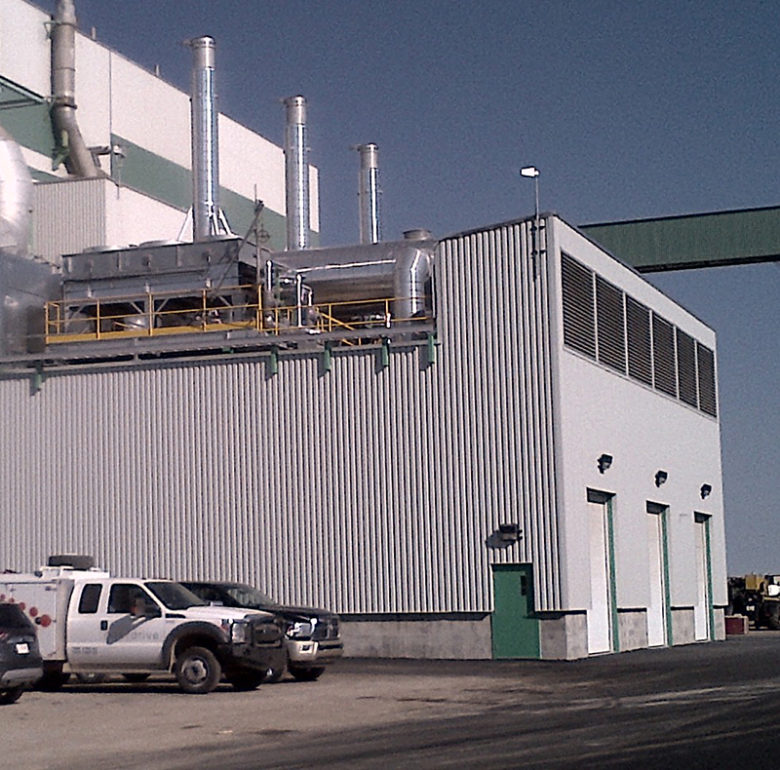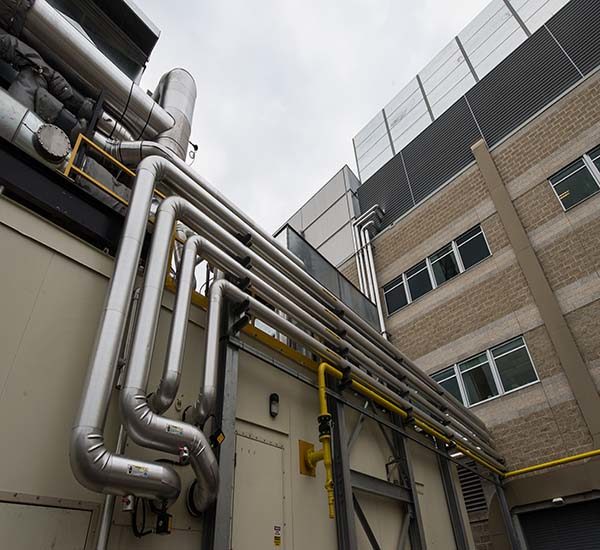Sector: Energy/Utilities
Public Works & Government Services Canada
Tunney’s Pasture
HH Angus was engaged as Prime Consultant on a chiller plant installation for this public building in Ottawa. The project installation serviced nineteen buildings with a total floor space of ~3,170,000 ft2 and was comprised of two chillers @3500 tons.
Tunney’s Pasture is a 49-hectare (121 acre) mixed-use campus in Ottawa, including government services, commercial offices and residential buildings. Its existing steam-driven chillers were at end of life and operating with R22 refrigerant, the import and production of which is banned as of January 2020. Also, the use of river water for free cooling needed improvement and the river water pumping system was not operating efficiently.
HH Angus, in joint venture with Goodkey Weedmark, was retained to undertake conceptual studies to evaluate changing the chillers from steam power to electrical power. We also made recommendations for improving the free cooling aspects of river water and making more effective use of the river water pumping system.
HH Angus provided conceptual evaluation of replacing the chillers, in terms of efficiency, physical location and necessary steps required to change from steam to electrical power. Once the chiller concept was resolved, we evaluated optimization of the river water pumps to undertake the condenser water cooling and considered how to efficiently use the free cooling available from the river in low load conditions.
Optimizing free cooling and condenser water, using river water instead of cooling towers, resulted in energy efficiency and reduced carbon footprint for this installation. We also identified benefits to the client through improvement in chiller efficiency using the latest technology, and the elimination of boiler operation during the summer months.
SERVICES
Prime Consultant | Mechanical Engineering | Electrical Engineering
PROJECT FEATURES
Status: Completed: 2017
LOCATION
Ottawa, Ontario
KEY SCOPE ELEMENTS
Evaluation to optimize river water pumps to undertake condenser water cooling & efficient use of free cooling from the river in low load conditions | Consulted on technology that would eliminate boiler operations during summer months
Enwave Energy Corporation
Pearl Street Cogeneration Plant
HH Angus provided design and engineering services for Enwave’s CHPSOP 2.0 contract to install a 2 x 2 MW Cogen project at the Pearl Street plant.
The Pearl Street steam plant is one of two major boiler plants that service Enwave’s downtown Toronto heating system, and usable plant space there was a significant constraint. The new cogeneration was to be installed in limited space in the basement.
We first undertook a feasibility study to determine whether the existing basement would accommodate a 4 MW single engine or 2 x 2 MW engines. Based on the study results, Enwave selected the 2 x 2MW option.
The initial phase of the detailed design was to determine which cogeneration engines would be options, given the space constraints. It was established that only one supplier’s equipment would fit. The next phase involved pre-tenders, including engine generator sets, heat recovery steam generator, selective catalytic reduction, and switch gear.
Plant design used 3D software to ensure all equipment could fit without coordination clashes. The combustion and ventilation required were a major challenge, entailing architectural changes to the building to meet code, and a new area way on the outside of the building, to allow for combustion air and ventilation air. The engine generator had to be disassembled at the distributor and reassembled on site. The focus then moved on to locating a suitable routing for the breeching and silencers off the engine exhausts, which had to travel from the basement to the roof.
In a CHPSOP 2 contract, the client is exporting power into local LDC (Toronto Hydro). HH Angus designed protection, monitoring, and control requirements per Toronto Hydro’s embedded generation technical interconnection requirements.
HH Angus coordinated with Toronto Hydro, on behalf of the client, for: revenue metering CTs/PTs to install in the switchgear hydro compartment; metering cabinet; and commissioning of the synchronization test, protection, and SCADA points. We also issued a signed, embedded generation commissioning report.
SERVICES
Mechanical Engineering | Electrical Engineering
PROJECT FEATURES
Status: Completed 2017
LOCATION
Toronto, Ontario
KEY SCOPE ELEMENTS
Use of 3D plant design to ensure all equipment could be accommodated | Design restricted by space constraints | Design, protection, monitoring & control requirements per Toronto Hydro's embedded generation technical interconnection requirements
McMaster University
Trigeneration Plant
HH Angus was initially engaged to perform a Detailed Engineering Study to determine the viability of installing a natural gas-fired turbine for power and steam generation, and the use of absorption cooling to balance out steam production in the warmer months.
For a full year, we reviewed heating, cooling and electrical power loading at McMaster University. We also reviewed operating costs covering maintenance, operating and natural gas costs, and completed a sensitivity analysis of gas and power pricing variances. Capital and Operating budgets were also prepared to determine ROI on the proposed investment.
Following the Detailed Engineering Study, we were engaged to design the new trigeneration plant using a gas turbine (5.4 MW) coupled with an HRSG (Heat Recovery Steam Generator), natural gas compressor, absorption chiller (1000 tons) and centrifugal chiller (2500 tons). The plant was installed in the existing central utility plant room, and significant demolition of redundant equipment was undertaken to generate the space for this system upgrade.
There were a number of interesting challenges associated with the work:
- Selective demolition of two existing steam boilers, two existing incinerators and one 5,000 ton electric centrifugal chiller including isolation of services and asbestos abatement to not impact existing plant operations
- Fitting this large equipment into an area with significant space constraints
- Creating a path of ingress for the equipment from outside into the sub-grade basement level of the plant for installation during winter months where the weather would be unpredictable
- Minimizing the impact on daily operations within the plant during the demolition and construction phases.
- Integration and coordination with a switchgear replacement project running in parallel with the cogeneration project
- Targeting a completion date of October, 2017 to ensure the client would receive full IESO funding for the project
Some of our solutions included:
- Thorough surveys of existing equipment and services to ensure the equipment slated for demolition could be isolated from the operating plant with minimal to no service interruption
- Engaging with equipment suppliers at an early date to ensure required footprints were allocated
- Coordinating with the structural engineers to design a removable roof cap that could be installed prior to the existing roof being cut open to allow equipment installation
- On-going coordination with plant staff during the design phase to get buy-in of any modifications required to the existing plant
- Pre-tendering long lead item equipment to ensure on-site delivery dates would meet the construction schedule
By designing to eliminate potential interferences or issues with installation, we were able to meet the delivery targets and deliver a successful project.
SERVICES
Prime Consultant | Mechanical Engineering | Electrical Engineering
PROJECT FEATURES
Status: Completed 2017
LOCATION
Hamilton, Ontario
KEY SCOPE ELEMENTS
Year-long detailed engineering study | Reviewed heating, cooling and electrical power loading | Study included sensitive analysis of gas and power pricing variances | Introduced new design for trigeneration plant usage, a gas turbine (5.4MW) coupled with an HRSG, natural gas compressor, absorbtion chiller and centrifugal chiller
Gas Drive
Slave Lake Pulp 9 MWe Cogeneration Project
Waste-activated sludge is produced in vast amounts at pulp mills, and is generally sent to be incinerated or landfilled, or can be land applied. Any of these options represented a lost opportunity at the Slave Lake Pulp plant in Alberta. The sludge would instead be repurposed to serve as the main ingredient for anaerobic digestion—a reliable, local, ongoing source of renewable energy.
HH Angus designed a 3 X 3 MWe bio-gas fed cogeneration plant for Slave Lake Pulp, a division of West Fraser Mills. The renewable energy technology integrates energy-efficient anaerobic digestion, using the pulp sludge, into the plant’s existing wastewater treatment system. This allows the plant to generate a methane-rich biogas that produces electricity and heat for the pulping process.
Our scope included: engineering electrical power equipment to integrate from the owner’s 13.8kV switchboard into the electrical generation system distribution to connect the cogeneration equipment; electrical design for a new engineered building housing the cogeneration machines and balance of plant; affiliated balance of plant engine electrical support services, such as high and low temperature cooling, exhaust gas heat exchanger and fresh/waste oil, glycol makeup systems, etc.
HH Angus prepared a 13.8kV single line diagram for the electrical system, from the power generation modules through the switchboards, to the interface to the utility service and existing owner’s distribution system; plus preparation of a 600V & 120/208V single line diagram for the generator, building auxiliary and balance of plant services. We also designed protection and control systems, and connection arrangements including SCADA with AESO.
SERVICES
Electrical Engineering | Commissioning support
PROJECT FEATURES
Status: Completed 2015
LOCATION
West Fraser Mills, Alberta
KEY SCOPE ELEMENTS
Designed a 3 X 3 MWe bio-gas fed cogeneration plant | Detailed design of power equipment to integrate to utility and owner’s existing plant | Initiated protection and control system designs Including connection arrangements - SCADA with AESO

Proven protection
We provided a detailed short circuit analysis and co-ordination protection setting study to satisfy the owner that their system is fully protected.
Energy win-win
“This system will now allow us to actually take advantage of some of this lost energy, while also reducing our consumption.”*
Rod Albers, Manager of Energy ad Bio-Product Development, West Fraser Mills

Thunder Bay Regional Health Sciences Centre
Cogeneration Plant
The Thunder Bay Regional Health Sciences Centre required a new outdoor enclosed cogeneration machine to be integrated into the existing mechanical and electrical hospital systems to displace utility electricity and boiler production.
As prime consultant, some of the challenges we overcame on this project included: meeting the delivery deadline under a very tight schedule once the project was approved to proceed; working under the confines of space constraints; noise suppression requirements associated with working in an operating healthcare facility; and integration and use of low temperature water from cogeneration.
To address these challenges, HH Angus pre-tendered the equipment, which allowed for unit production while mechanical and electrical design continued. To address the issue of noise infiltration to the hospital, the unit noise suppression was specified to very strict levels, and these were successfully met.
Although low temperature heat is normally unused in this process and is displaced to the atmosphere, our design incorporated low temperature heat along with high temperature waste heat for use in the dearator make-up. This feature adds a level of long-term efficiency to the installation.
SERVICES
Prime Consultant | Mechanical Engineering | Electrical Engineering | Civil Engineering | Structural Engineering
PROJECT FEATURES
Size: 1.5 MW | Status: Completed 2015
LOCATION
Thunder Bay, Ontario
KEY SCOPE ELEMENTS
Integration of new outdoor cogeneration plant into existing hospital M&E systems | Aggressive delivery schedule | Mitigation of noise and space constraints

Meeting deadlines
Despite a very tight schedule, the project was completed on time and within budget.
